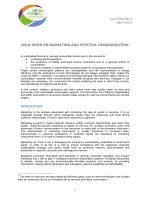Taha presentation Effective Marketing
Bạn đang xem bản rút gọn của tài liệu. Xem và tải ngay bản đầy đủ của tài liệu tại đây (576.28 KB, 11 trang )
M. Taha Uddin Khan Ghori
Submitted To : Sir Ghayaz
Gr#: 112047
William Procter, a candle maker, and James Gamble, a soap
maker, emigrated from England and Ireland respectively.
Their father-in-law called a meeting and persuaded his son-in-laws to
become business partners. On the 31st of October the Procter & Gamble
company was created.
They began by supplying the Union Army with soap and candles.
Introduction
•
•
•
•
•
•
•
The Proctor & Gamble company also knows as P&G is an American multinational
consumer goods company headquartered in downtown Cincinnati, Ohio, USA.
P&G was founded in 1837 by William Procter and James Gamble.
First products were soaps and candles
Now P&G has two dimensions of products hygiene and health Care and home
products with 23 brands.
The P&G community includes approximately 138,000 employees working in about
80 countries worldwide and provide services in 180 countries.
In fiscal year 2014, it has sales revenue of $83 billion.
P&G Ranked #41 on the list of the World’s Most Reputable Companies in Forbes.
EVOLUTION OF LOGO
Introduction
Competitors:
•
Nestlé
•
Reckitt Benckiser
•
Unilever Co.
•
Sara Lee
•
Johnson & Johnson Co.
•
Kimberly-Clark Co.
VISION STATEMENT:
Be, and be recognized as, the best consumer products and services company in the
world.
MISSION STATEMENT:
We will provide branded products and services of superior quality and value that
improve the lives of the world’s consumers, now and for generations to come. As a
result, consumers will reward us with leadership sales, profit and value creation,
allowing our people, our shareholders and the communities in which we live and
work to prosper
Evaluating mission statement
•
•
•
•
•
•
•
•
•
1. Customers
2. Products or services
3. Markets
4. Technology
5. Concern for survival, growth, and profitability
6. Philosophy
7. Self-concept
8. Concern for public image
9. Concern for employees
Evaluating mission statement
We will provide branded products and services of superior quality and
value that improve the lives of the world's consumers.[1, 3 and 7] As
a result, consumers will reward us with leadership sales, profit, and
value creation, allowing our people, our shareholders, and the
communities in which we live and work to prosper.[5, 8 and 9]
Recommendation:
We will improve our consumers’ lives a little better but in meaningful
ways each day by means of technological advances and meeting
their demands for household and personal products. [6,4 and 2]
Current strategies
• Consumer will pay a premium for products that offer improvements
over either private-label products or the brand they have bought for
years.
• Product innovation must be regular with visible improvements, in years
constantly.
• Product innovation must be designed to constantly “up-scale”
consumer preferences.
• This “up-scaling” of consumer tastes is not just for affluent consumers.
• These strategies can be used to break into developing economies.
• Using innovation to attain a growing share in the developing markets
will be the key to growing companies earnings as growth rate in mature
consumer markets.
Short-term objectives
•
•
•
•
•
Build existing core businesses into stronger global leaders.
Grow leading brands, big countries, winning customers.
Develop faster-growing, higher margin with global leadership potential.
Regain growth momentum and leadership across Europe and other parts of the
world.
Drive growth in key developing markets.
Long-term Objectives
• In fact, the company has an avowed aim of reaching an additional 1 billion consumers in the
next five years, taking its total to 5.2 billion, well over half the global population.
• P&G acknowledges it will take decades to make the vision a reality and to ensure it has teeth,
has set 10 year targets for each of the five long-term commitments, which are:
1.Powering its plants with 100% renewable energy
2.Using 100% renewable or recycled materials for all products and packaging
3.Having zero consumer and manufacturing waste go to landfills
4.Designing products that delight consumers while maximizing the conservation of resources
5.Delivering effluent water quality that is as good as or better then influent water quality with
no contribution to water scarcity









